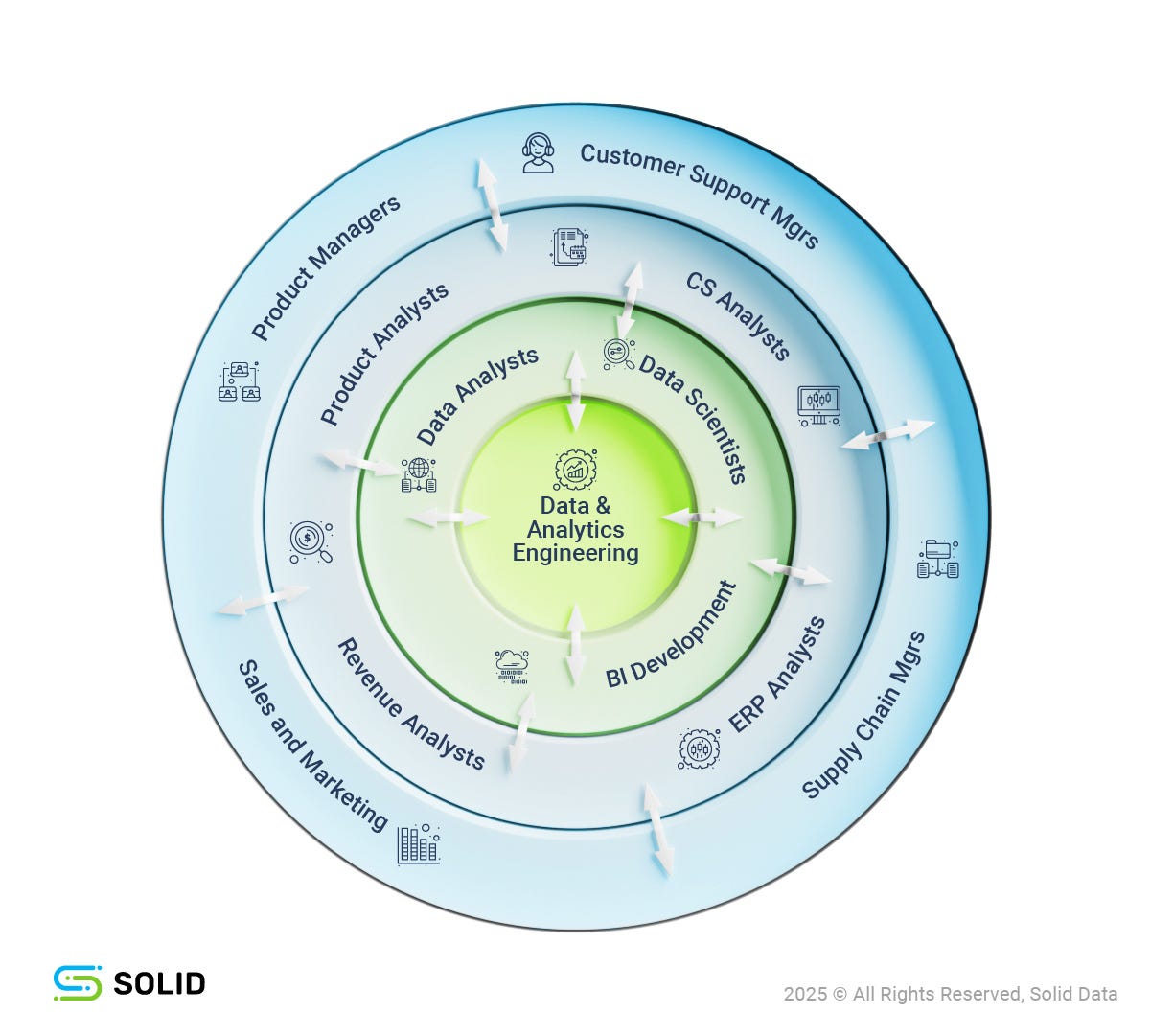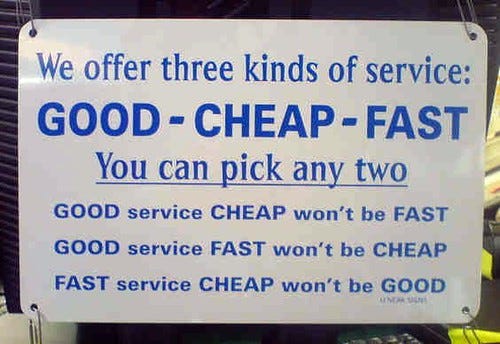The five tier-model of organizational data and analytics flow
Across 180+ conversations with D&A leaders and business stakeholders, we've uncovered an interesting model that can help focus the investment in analytics for business benefit
So, your organization has a CDAO, or CDO, or VP of Data, or VP of Analytics, or some mix of those titles. And your CDAO is cool now. Hopefully, that same leader, is thinking about how best to impact the business departments across the company.
In my last post we talked about the need to get closer to the business, and in this blog post, we’re going to discuss the mental diagram of the relationship between teams across the organization and some framework for improving their happiness and productivity.

Background
As you can see in the diagram above, there are five tiers. Starting from the center:
Tier 0 - data engineering - responsible for collecting, organizing, curating and governing the data. They report to the D&A leader.
Tier 1 - data analysts, data scientists and BI developers - the former two access and analyze data based on ad-hoc requests from Tier 2, while the latter build (hopefully) reusable dashboards for Tier 2+ users. Sometimes, these are the same people. This tier also usually reports to the D&A leader and interact a lot with Tier 0.
Tier 2 - analysts within “the business” - while the Tier 1 personnel usually report to a head of data or analytics, the Tier 2 personnel usually report to a business leader or business function. These Tier 2 personnel know their respective part of the business better than Tier 1, but don’t know the data as well.
Tier 2 are spread all over the company. Sometimes, they have a guild, or a community, to help them share knowledge.
Tier 3 - “power” business stakeholders - these are business stakeholders who are not analysts, but have a strong desire to leverage data and analytics to make better decisions. Sometimes these people can run SQL on their own, or even build some mini dashboards. They regularly consume dashboards and interact with Tier 2.
Tier 4 - the rest of the organization - these are people with various levels of affinity to the use of data and analytics. You could break this tier into more sub-tiers, but for the purpose of this conversation there’s no need. They generally use dashboards and reports that were made available for broader use.
As you get further away from the center, every Tier has many more people in it. For example, Tier 0 might have 10 people, whereas Tier 1 50, Tier 2 200, and so forth.
Where we see organizations suffer, is in the handoff between each tier, for example:
When Tier 3 wants to make a decision using data, they may try to self-serve. If they succeed, great. If they fail, they reach out to Tier 2, who try to help them. If they can’t, it goes to Tier 1, etc. This causes a broken-phone situation, and a massive waste of time.
A single request can easily span weeks, if not months, the deeper it goes into the “core” of this diagram.
As humans, we like to associate ourselves with our “teams”. Us, vs them. Even within the same company. Unfortunately, this means that people in one tier will often complain about people in the two adjacent tiers:
“They don’t know what they want” (when speaking of a higher tier)
“They don’t know what I need” (when speaking of a lower tier)
“They take too long” (again, lower tier)
“I wish they could be more independent” (when speaking of a higher tier)
So imagine that in the diagram above there are arrows - business needs flow from the outside inwards, whereas data models and analytics flow from the inside out.
D&A leaders are acutely aware of these challenges, and are trying to solve it. The more work you can push from a given tier (X) to a higher tier (X+1), in a manner that is easy for the higher tier (X+1) to complete, the happier and more productive both tiers become.
Let’s discuss some solutions.
Data Democratization - success or failure?
In concept, Data Democratization, is a means of doing this - by helping the outer tiers become more independent. But, the more power you give the outer tiers, the more likely they are to shoot themselves in the foot - use the wrong data to get to the wrong conclusions. ThoughtSpot is a great example here - many D&A leaders love it because it allows Tiers 2, 3 and 4 to get what they need without needing Tiers 0 and 1. You get faster time to insight, and Tiers 0 and 1 get less “interrupts”.
But, there’s only so much you can do there. So, into the picture comes Alteryx. They have a very powerful solution that lets Tier 2+ take a step further and start modeling and messing with the data more. This is a more extreme case of data democratization.
Interestingly, many CDAOs we’ve met with, who have Alteryx deployed in their company, hate it with a passion. Of course, many CDAOs like Alteryx, but it was surprising to witness. We asked them - why? Their answer: Alteryx moves the power to the people - those outer tiers - but to such a degree where central governance on how data is modeled and used may be lost. The D&A leader is losing control and they are unhappy about it.
The D&A leader is right - their job is to make sure the data is used correctly, to produce reliable analytics and better business decisions.
But, also the outer tiers are right - they need faster time to insight and cannot be bogged down by the inner tiers, the broken phone process, and the time wasted.
Data Dictatorship - the pendulum swings back
So many things in humanity swing back and forth like pendulums, and this is no exception. We heard the term Data Dictatorship from an analytics leader based in NY (not sure if that’s surprising or not). It’s a sort of whiplash response to the over-democratization of data.
In this case, the theory is that Tiers 0 and 1 need to control all of the data sets, make sure everything is nice and clean, maybe even following the medallion architecture. They should also control the generation and deprecation of dashboards. This avoids people making their own stuff up.
But - this pushes us back into the problem of speed - if Tiers 2+ don’t get what they need at the speed they need, they will become unhappy. They will look for ways to circumvent the data team (Alteryx…) or get the leader fired (we’ve seen that, too). After all, a dictator only stays in power for an average of 13 years.
Is a better balance becoming available?

The cheap/fast/good triangle discussed in the above sign is well known at this point. I generally agree with what it says, with one exception: Major innovations allow for improvement across all three axes. You can get something better, and cheaper, and faster. You just need some revolutionary technology, ideally one that is only two letters and been all the rage recently.
Or, in the context of our blog post here, there is a possibility to increase the satisfaction of all tiers at the same time, and not one at the expense of the other. All you need is a solution that:
Makes it easier for the outer tiers to self serve.
Makes it easier for the inner tiers to understand the outer tiers’ needs better.
Allows the inner tiers to deliver data models and analytics outwards faster.
I wonder where one might find such a solution?

